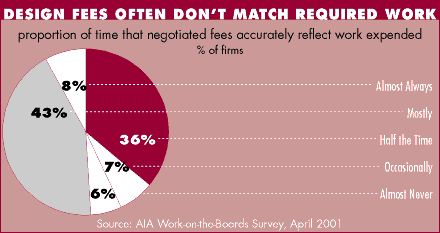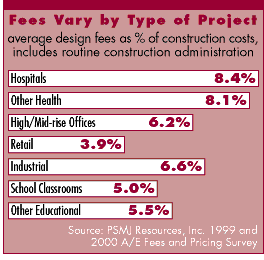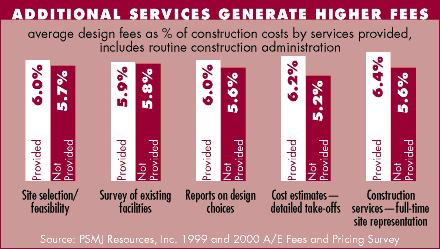
A systematic approach helps ensure more accurate results

AIA Chief Economist
Even in the best of economic times, architecture firms can run into financial problems if fees are not estimated properly. For example, even though profits at firms were running in the double-digit range in 1999, 8% of firms reported a loss that year, and an additional 23% reported profits of less than 5% of billings, according to the 2000–2002 Firm Survey. It is likely that many of these firms faced financial difficulties due to problems in accurately estimating fees.
About half of architecture firms report chronic problems in accurately estimating fees. Earlier this year, the AIA Work-on-the-Boards panel was asked to estimate the proportion of the time that design fees negotiated by the firm accurately reflect the amount of work actually expended on the project. Fewer than one in 10 firms responded that this was the case almost always, and over 4 in 10 indicated that this was the case most of the time. For the rest of firms, however, matching fees and effort levels apparently is a common problem.

Accurately linking fees to effort levels is not only a problem for smaller and younger firms that may lack experience in estimating projects. Firms with 50 or more employees are just as likely to express concerns in estimating design services as are smaller firms. One reason is that firms of all sizes are offering a broader range of services. An increasing share of larger firms are offering a full range of design disciplines—including engineering, interiors, landscape, and planning services—and firms of all sizes are more likely to be offering predesign, construction-phase, or post-construction services to clients. With limited experience in offering these services, estimating effort levels can be problematic.
Factors influencing
fees
There are five major factors influencing project costs that should be
considered in pricing design services for a construction project:
• Type of project
• Scope of services provided
• Scale of project
• Risk assumed by firm
• Estimating detail.
 The
type of project, which often dictates the type and level of design services
to be provided, is the most commonly used method to distinguish fee levels.
Information on fees from a large database of projects bid in 1999 and
2000 and assembled by PSMJ Resources indicates that there is considerable
variation in fees across different building types. Average fees for retail
facilities, for example, were half of those for hospitals and other health-care
facilities. (These figures are averages for projects where normal design
services were bid as a package. They may not be representative of projects
for which the architectural design services are bid separately from engineering
services.)
The
type of project, which often dictates the type and level of design services
to be provided, is the most commonly used method to distinguish fee levels.
Information on fees from a large database of projects bid in 1999 and
2000 and assembled by PSMJ Resources indicates that there is considerable
variation in fees across different building types. Average fees for retail
facilities, for example, were half of those for hospitals and other health-care
facilities. (These figures are averages for projects where normal design
services were bid as a package. They may not be representative of projects
for which the architectural design services are bid separately from engineering
services.)
Service package reflected
in fees
Architecture firms are still developing their sophistication in estimating
effort levels for the expanded set of services they increasingly are offering
on projects. More commonly, firms are pricing these services separately
in an "a la carte" approach, as opposed to bundling them together
for a package bid. However, because many firms have not offered all of
these services extensively, estimating the required effort level is not
an exact science. There is evidence, however, that firms are beginning
to move away from a standard package approach in developing bids, and
instead are factoring in more detailed estimates of the costs of providing
expanded services.

It is commonly assumed that there are economies of scale in the provision of design services. That being the case, design services for larger projects would be bid at a lower share of total construction costs than for smaller projects.
 There
may be economies of scale to a point, but other issues that are involved
in the design of larger projects apparently offset these economies. The
result is that fees as a percentage of construction costs are highest
for smaller (projects with fees under $500,000) and very large construction
projects (with fees in excess of $5 million). Larger projects are often
unique along several dimensions and therefore present design challenges
that require additional effort.
There
may be economies of scale to a point, but other issues that are involved
in the design of larger projects apparently offset these economies. The
result is that fees as a percentage of construction costs are highest
for smaller (projects with fees under $500,000) and very large construction
projects (with fees in excess of $5 million). Larger projects are often
unique along several dimensions and therefore present design challenges
that require additional effort.
Pricing risk in fee
estimates
One of the most difficult challenges in estimating effort levels for projects
is to identify the risk of the project and price that risk appropriately.
For architects, it is useful to think of two types of risk: bid risk and
project risk.
Bid risk encompasses the costs that the firm will absorb if the work can't be completed within the estimated effort level. Fixed-price fees and fees that are tied to the overall construction costs are therefore the riskiest to the firm. Fee contracts that are based on the actual level of effort expended-such as hourly reimbursement, time and materials, and cost plus fixed-fee-have less risk to the firm because they are compensated for work actually expended. Also, if the firm serves as the architect-of-record for a project and subcontracts out some of the responsibility, it is assuming greater levels of risk because some of the subs may not deliver what was expected of them in a timely manner.
Project risk encompasses a range of factors related
to the actual development of the project. These factors generally are
concerns over which the architecture firm has limited control. Examples
of risks that a firm should consider are what happens if:
• Financing for the project can't be obtained
• The local market collapses before the project gets built
• Local opposition stalls the development of a project
• The architect is to be paid after the building is occupied, and
there are delays in getting to this phase.
Many of these risks are difficult to anticipate, but a firm can begin to estimate them based on its knowledge of the client and the project and based on the nature of the agreement between the owner and architect.
Finally, a concern related to risk is that many firms use standard rules-of-thumb to estimate design fees. A firm may routinely bid the design of office buildings at a fixed dollar amount per square foot or a fixed percentage of construction costs. Again, if there are unique characteristics of a specific project that influence costs, the firm may find that general rule-of-thumb estimates are not accurate. And the impact of these circumstances will be shouldered by the firm and reflected in its profitability.
Copyright 2001 The American Institute of Architects. All rights reserved.
![]()
|
|
|